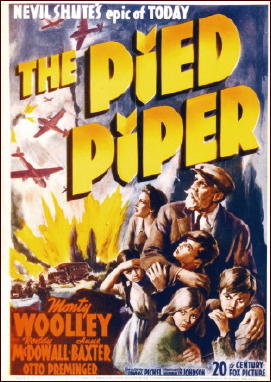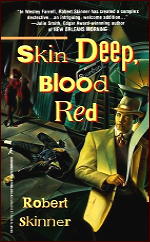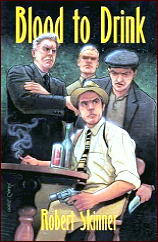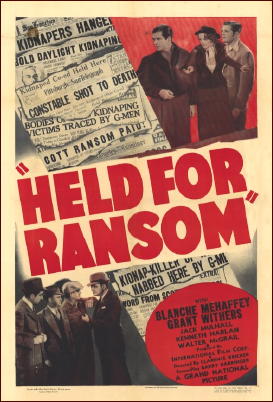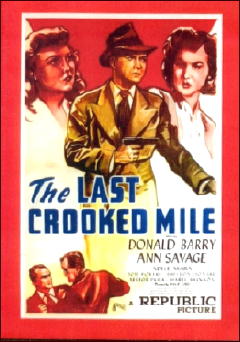April 2012
Monthly Archive
Tue 17 Apr 2012
REVIEWED BY WALTER ALBERT:

THE PIED PIPER. 20th Century Fox, 1942. Monty Woolley, Roddy McDowall, Anne Baxter, Otto Preminger, J. Carrol Naish, Peggy Ann Garner, Marcel Dalio, Marcelle Corday, Odette Myrtil, Helmut Dantine. Screenplay by Nunnally Johnson from a novel by Nevil Shute. Director: Irving Pichel. Shown at Cinevent 35, Columbus OH, May 2003.
There was a time when I objected to the addition of films from the 1940s to the programs at Cinevent, but the quality of productions like this one I has pretty much taken care of my objections.
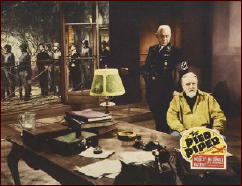
Woolley is an Englishman vacationing in France in the spring of 1940 as the Germans have swept across France and are beginning to think of conquering England. As Woolley attempts to return to England in advance of the German army, he acquires — against his curmudgeonly objections — a group of English and French children he attempts to shepherd to safety.
Their escape — with the help of sympathetic French patriots — seems assured until they fall into the hands of a German company headed by Major Diessen, played by Otto Preminger.
Garner and MacDowall are both superb and there’s not a typical Hollywood child actor in the small group recruited for the film. I’ve listed some of the French actors in the film. Although their roles are small, they are distinguished film performers. (Dalio starred in Jean Renoir’s masterly The Rules of the Game.) I found this to be a moving film, and with not a false step by the numerous fine actors.
YouTube Notes: The confrontation scene between Preminger and Woolley can be seen here. A longer ten-minute clip can be found here. This one’s from earlier in the movie, as Monte Woolley begins to discover what fate has in store for him.
The film was nominated for three Academy Awards: for Best Picture, losing to Mrs. Miniver; Best Actor, with Wooley losing to James Cagney for Yankee Doodle Dandy; and Best Cinematography.
Tue 17 Apr 2012
ROBERT SKINNER – Daddy’s Gone A-Hunting. Poisoned Pen Press, hardcover, 1999; trade paperback, 2000. Hardcover reprint: Detective Book Club, 3-in-1 edition.
At the present time there are six books in Robert Skinner’s series of Wesley Farrell adventures, of which this is the third:
Skin Deep, Blood Red (Kensington, 1997) [Nominated for the Anthony Award for Best First Novel.]
Cat-Eyed Trouble (Kensington, 1998)
Daddy’s Gone A-Hunting (Poisoned Pen, 1999)
Blood to Drink (Poisoned Pen, 2000)
Pale Shadow (Poisoned Pen, 2001)
The Righteous Cut (Poisoned Pen, 2002)
Wesley Farrell is a mixed-blood Creole by birth, but at the time of this book, which is 1938, he’d been living in New Orleans as a white man for over 25 years. He’s a legend of a man — a night club owner whom everyone in the city seems to know and will defer to, rather than get on the wrong side of him. Nonetheless (and inevitably) it’s strictly his reputation that gets him into trouble this time.
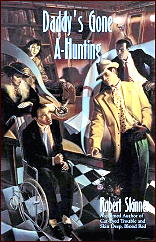
There are several threads of the widely rambling plot. The major one centers on the deaths or mysterious disappearances of prominent members of the aforementioned black community. Less important, or so it seems, is the request that Carol Donovan (*), the beautiful black owner of The Original Southport Club, makes of Farrell. She needs his help in fighting a tough thug named Archie Badeaux who has been making threats against her.
A stash of stolen money that has gone missing is also involved, and when Ernie LeDoux gets out of prison and starts looking for it, a brand new series of events is pushed into motion. And there’s more. It takes well over 300 pages of fine action-oriented fiction to cover it all.
Great characters and great atmosphere combine to make Gone A-Hunting very enjoyable reading. Back in 1938, and particularly in the South, there was an entire black community whose activities never made the white newspapers, and they certainly weren’t recorded in the white history books.
A separate black squad of the detectives in the police department, black bankers and real estate agents — an entirely separate (but not equal) citizenry — which you notice most when you are reminded, as Skinner does, that trains, for example, had separate cars for blacks.
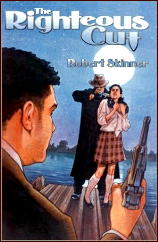
Most of the threads of plot come together at the end, but not all. In all truthfulness they’re spread too thin to have the depth that would make this an absolute knockout of a novel. Sometimes the longer the book, the weaker the punch. The clues which the detection depends upon are suspect as well — what kind of witless killer would vomit at each of his scenes of the crime, and fail to clean up his mess afterward?
But there are more adventures to come, and a couple of priors to catch up with also. I came in at the middle, and now with two different ways to go, I fully intend to.
(*) PostScript: Here’s a quote that here, just now, at the last minute, I decided to leave you with. From page 21:
A beautiful Negro woman of about thirty came through the doors of the Café Tristesse [Farrell’s place] like she owned the joint. She was about five-and-a-half feet tall, with skin so pale brown it was no darker than a suntan, shoulder-length black hair, and eyes like obsidian. The only makeup on her fine-featured face was lip rouge the color of ripe plums. Dressed in a pale yellow dress, yellow sling-back pumps, and a yellow hat that was like gold ornamentation on a queen, she was enough to make a Baptist minister drink swamp water, crawl inside a hollow log, and bay at the moon.
Maybe Halle Berry could play the part? I was leaning toward a younger Richard Roundtree as Farrell, back when he played Shaft in the movies. When I mentioned this to another reader of the series (female), she immediately reminded me that Farrell is passing for white, and Roundtree is therefore too dark.
She then suggested Giancarlo Esposito, who appears on some television show I don’t watch. I obviously have to think this over some more.
Mon 16 Apr 2012
Reviewed by Michael Shonk
CITY OF ANGELS. NBC / Universal, 1976. Roy Huggins Public Art Production. Cast: Wayne Rogers as Jake Axminster, Elaine Joyce as Marsha Finch, Philip Sterling as Michael Brimm, Clifton James as Lt. Quint. Created by Stephen Cannell and Roy Huggins. Executive Producer: Jo Swerling Jr.
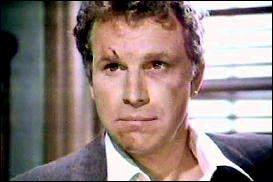
From the opening theme to the star and the writing, City of Angels tried to give us a believable 30’s hardboiled PI and occasionally succeeded, as in “The November Plan,†but more often failed.
For example, listen to Oscar winner Nelson Riddle’s theme here.
A nice theme but it fails to establish the 1930’s setting or mood. The soundtrack made heavy use of the Universal sound library, so far too often we heard generic background music that also failed to fit the time period. Though in a couple of episodes such as “Say Goodbye to Yesterday†the background music was a positive asset to the story.
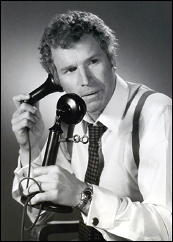
The writers tried to take advantage of the volatile period of American history that was the 1930s. To establish setting the series often name-dropped (Harry Cohn of Superior Pictures aka Columbia Pictures) and used the politics of the period as the backdrop for the drama. But in the end the episodes were typical TV mysteries, rushed from lack of production time with clunky dialog, plot holes and often lacking in logic.
Much like Philip Marlowe, Jake spent much of his time dealing with the problems of the rich. Jake began as a mercenary Sam Spade wannabe who enjoyed the thrill of fighting the system, then during the series changed into a hard luck James Rockford type.
Jake had only two friends in the world. Marsha, who he let use his outer office rent-free for her switchboard service used by prostitutes, and Mike, his attorney with an office across the hall. He either was beat up by or bribed his police contact Lt. Quint.
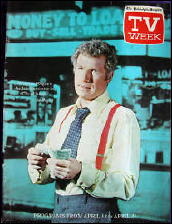
To be a hardboiled PI, a character that is often unlikable, you need an actor with certain type of appeal. Actors such as Bogart, Mitchum, Garner and Janssen could make you like the character no matter how the character behaved. Wayne Rogers never pulled it off despite coming close in “The November Plan.â€
The costumes, transportation, and locations were generally a plus, but by the end of the series it seemed as if they were running out of 1930s-like exterior locations.
From the beginning, Roy Huggins was credited as producer with Philip DeGuere, Jr. as executive story consultant until the episode “A Sudden Silence.†The credits for the rest of the series episodes changed to Philip DeGuere, Jr. and William F. Phillips as the producers instead of Huggins. Perhaps it is time to consider the influence of the late Philip DeGuere, Jr. (Simon and Simon) on the series.
City of Angels aired Tuesday at 10pm opposite ABC’s Marcus Welby (or Family in March/April) and CBS’s Switch. The ratings began well but faded fast.
EPISODE GUIDE:
“The November Plan.†Part 1 (2/3/76), Part Two (2/10/76), Part Three (2/17/76). Teleplay by Stephen J. Cannell. Story by Roy Huggins and Stephen J. Cannell. Directed by Don Medford. Guest Cast: Diane Ladd, Meredith Baxter Birney, Laurence Luckinbill, Lloyd Nolan, Dorothy Malone, Jack Kruschen, Steve Kanaly * Jake’s client has been framed for murder of her boyfriend after they witness a fight at a formal party. Jake discovers the disappearance of a Pulitzer prized reporter ties into the murder and involves some of the most powerful corrupt people in Los Angeles. Very loosely based on a real event.
“The Parting Shot.†(2/24/76). Teleplay by Philip DeGuere Jr. Story by John Thomas James (Roy Huggins). Directed by Sigmund Neufeld Jr. Guest Cast: Donna Mills, Corinne Michaels, Stefan Gerasch * Rich man hires Jake to discover if his wife is cheating on him. Before Jake finds out anything his client is shot and in a coma. The man assumed to be the wife’s lover is arrested. The daughter who hates her step-mom likes Jake. The solution to the shooting reminds one of John Dickson Carr.
“A Lonely Way To Die.†(3/2/76). Written and Directed by Douglas Heyes. Guest Cast: Belinda J. Montgomery, William Smith, Lynn Carlin * A predictable mystery features a popular ex-governor who wants to be President but has a secret. His rebellious daughter blames him for her mother’s mental problems. Jake gets involved when a girl he was trying to help turns up dead. The ending wants to be cynical but instead was a lame cop out.
“The House on Orange Grove Avenue.†(3/16/76). Teleplay by Stephen & Elinor Karpf. Story by John Thomas James. Directed by Robert Douglas. Guest Cast: Susan Howard, Susan Sullivan, Lara Parker * Jake is hired by two sisters publicly believed to have murdered one’s husband and his mistress seven years ago. The episode drowns in false cynicism with a weak pointless ending.
“Palm Springs Answer.†(3/23/76). Teleplay by Merwin Gerard. Story by John Thomas James. Directed by Allen Reisner. Guest Cast: Signe Hasso, Terry Kiser, George Gaynes * Sweet naïve mother hires Jake to find her good girl daughter, who is really a dancer with information about a murder with mob connections.
“The Losers.†(4/6/76). Teleplay by Gloryette Clark & John Thomas James. Story by John Thomas James. Directed by Barry Shear. Guest Cast: Marcia Strassman, Brett Halsey, Broderick Crawford * Loyal remake of Roy Huggins’ script for the TV Movie The Outsider minus the LSD subplot and visits to the L.A. nightclub scene (reviewed here on this blog). Jake is hired by a rich businessman to follow a girl he claims may be stealing from him.
“A Sudden Silence.†(4/13/76). Teleplay by Douglas Heyes. Story by Roy Huggins (not John Thomas James). Directed by Douglas Heyes. Guest Cast: Darleen Carr, Joel Fabian, Edward Winter * Young headstrong daughter of a rich conservative is involved with the anti-fascist movement growing on her college campus. She hires Jake to discover who is following her. Her boyfriend is murdered and the politics of the 30s plays a major role in the plot.
“The Castle of Dreams.†(4/20/76). Teleplay by Stephen J. Cannell. Story By Stephen J. Cannell and Philip DeGuere Jr. Directed by Robert Douglas. Guest Cast: James Luisi Veronica Hamel, Jack Kruschen * Marsha witnesses the kidnapping of one of her call girls who had just witnessed a murder. Jake goes nuts when Marsha is arrested and Quint hides her from lawyer Mike Brimm and Jake. This episode was more interested in establishing the relationship between the regulars than the mystery.
“Say Goodbye To Yesterday.”(5/4/76). Teleplay by Gloryette Clark. Story by John Thomas James. Directed by Jerry London. Guest Cast: G.D. Spradlin, Cassie Yates, Jack Colvin * A rich oil tycoon and his wife are in love. When she disappears, Jake is hired to find her. The trail leads to a Chinese Madame in Portland, a nightclub singer, a nun, and a murder Jake will solve for Quint.
“The Bloodshot Eye.†(5/11/76). Written by Philip DeGuere, Jr. Directed by Hy Averback. Guest Cast: Geoffrey Lewis, Charles Tyner, Robert Donner * Insurance agency hires Jake to confirm the reports of a death of a man in New Mexico. Jake ends up caught up in the corruption of a small New Mexico town.
“Match Point.†(5/18/76). Written by Richard Boeth. Directed by Ralph Senensky. Guest Cast: Dana Wynter, Renee Jarrett, Victor Holchak * A man is killed during a tennis tournament where Jake provided security. The political changes in Europe play an important role.
The series is currently not available on official DVD or download. Source of episodes: Thomas Film Classics
Sun 15 Apr 2012
A 1001 MIDNIGHTS Review
by Charles Shibuk
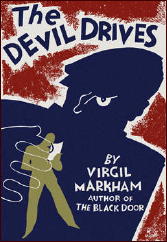
VIRGIL MARKHAM – The Devil Drives. Alfred A. Knopf, hardcover, 1932. Bart House #10, paperback, 1944. Ramble House, trade paperback, 2007.
The Devil Drives is an offbeat and highly individual novel by a writer who, it would seem, must have had some familiarity with the work of that master American zany Harry Stephen Keeler. It is somewhat reminiscent of Keeler’s Amazing Web (1929), but is shorter, slighter, less ambitious, more straightforward, and, though complex enough in plot, lacks the unbelievable convolutions and ramifications of the Keeler work.
The authors do share the ability to propel their narratives forward in such a manner that readers will keep turning pages breathlessly in order to discover what astounding plot development will next occur, and what outrageous coincidence will help to resolve (or amplify) the current situation.
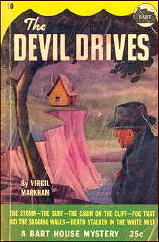
The Markham novel concerns George Lawson Peters, the warden of Franklin Penitentiary in New Jersey, who deserts his post to seek a lost treasure left by an adventurer nicknamed “Dubrosky” for a girl named Philadelphia Boston. On his odyssey, Peters meets a gangster with a heart of garbage; a repulsive blackmailer who exacts no tribute from his victims; the blackmailer’s unhappy wife; her friend the eccentric countess; and Detective Veen, who reads mysteries.
At the two-thirds point in the narrative, Peters encounters a honey of a locked-room problem. The door is locked and bolted, and the two windows are locked-all from the inside. The floor and ceiling are ungimmicked, and the fireplace and chimney show no signs of entrance or egress. The victim met his death by drowning. The author’s unique solution is even more bizarre than the problem he has propounded.
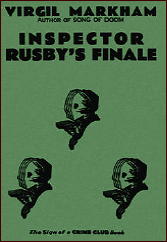
The locked-room situation and many strands of the plot are finally resolved by a few well-placed Keeleresque coincidences. But Markham has still done an ingenious job of deceptive clue-planting that is worthy of Christie, Carr, or Queen; and his unexpected and grimly ironic finale is worthy of Francis Iles or Richard Hull.
Markham’s other novels include Death in the Dusk (1928), The Black Door (1930), and Inspector Rusby’s Finale (1933). The last-named title has an irresistible premise:
A Scotland Yard inspector, spending a weekend at a crowded country house, wakes up the morning after his arrival to find that the hostess and guests have vanished and he is alone — except for the dead body of a perfect stranger. The ending, however, as Barzun and Taylor have noted, is a bit hard to swallow.
———
Reprinted with permission from 1001 Midnights, edited by Bill Pronzini & Marcia Muller and published by The Battered Silicon Dispatch Box, 2007. Copyright © 1986, 2007 by the Pronzini-Muller Family Trust.
Editorial Comments: Curt Evans recently posted on his blog a review of Red Warning (aka Song of Doom in the UK), another work of crime fiction by Virgil Markham. Included with the review is a considerable amount of information about the author himself, and I highly recommend it to you. (Follow the link.)
More. A link on Curt’s blog led to blogger TomCat’s review of Death in the Dusk, also by Markham, which he says “turned out to be a rival for Joel Townsley Rogers’ The Red Right Hand (1945) and Fredric Brown’s Night of the Jabberwock (1950) in the race for the title of most outlandish detective story ever contrived.”
Sat 14 Apr 2012
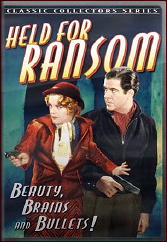
HELD FOR RANSOM. Grand National Pictures, 1938. Blanche Mehaffey, Grant Withers, Bruce Warren, Jack Mulhall, Kenneth Harlan, Walter McGrail, Robert McKenzie. Director: Clarence Bricker.
Kidnapping is a federal crime, so it stands to reason that Betty Mason (Blanche Mehaffey) is working as a federal agent when she goes undercover to tackle this case. The ransom has been paid, but the victim has not been released. The police suspect the man’s nephew (Grant Withers) as part of an inside job, but Betty is wise enough to keep all her options open.
I say “it stands to reason†in that opening paragraph, because the storyline of this film is plagued by some of the worst continuity and opening expository material I can think of, poverty row B-film or not. Events happen without explanation to characters who are not introduced, until later. I gave up once and started the film again, which helped a little.
Once beyond the first 15 minutes or so, it settles down into a fairly enjoyable detective yarn. The lack of money behind the film’s production is an obvious drawback, but there are two good reasons why I can recommend Held for Ransom to you, with only the reservations I’ve stated so far.
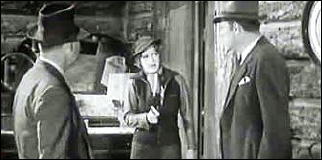
The first is the on-location shooting, that of an authentic mountain resort area around a lake somewhere near San Bernardino (Cedar Lake, IMDB says). It reminded me of several motor trips my family and I took when I was a kid, though we never made to California until the mid-1960s. The old general store with the ubiquitous candy bar ads plastered here and there brought back a lot of memories.
The other reason — and this is the primary one — is the role of Blanche Mehaffey as a tough-as-she-needs-to-be policewoman, as handy with a gun as climbing out a window on bedsheets tied together and rowing across the lake at midnight. Crime action movies in 1938 like this one did not often have a female in the lead, not without a comedy sidekick or boy friend. This one doesn’t, and it’s all the better for it.
The curly-haired and good-looking Mehaffey had a long career in silent films, beginning in 1923, but she seems to have made the into the sound era with no difficulties. Unfortunately she made only one more movie after this one, retiring from Hollywood when she was still only 31.
Sat 14 Apr 2012
Posted by Steve under
Reviews[3] Comments
CLAYTON MOORE – Secret Fire. Berkley, paperback original; 1st printing, January 1975.
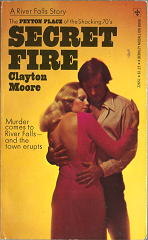
Our next entry in this blog’s “How Obscure Can You Get?†obsession is almost totally so, in my opinion. Notwithstanding the fact that this is the sixth book in the author’s “River Falls†series, making it appear to have been reasonably popular at the time, its time has come and gone, with very few still alive to remember – and it was published only 37 years ago.
There are five copies available for sale on ABE, but it will cost you $12 (plus shipping) to get one in more than only good condition. (And keep in mind that in book parlance, “good†does not mean good.) An unexplained, suspicious death does occur, and a trial takes up most of the second half of the book, but it is not (yet) included in Al Hubin’s Crime Fiction IV, although two of the earlier books in the series are. (As a brief aside, I do not know how many books in the series there are. This one appears to be the last, but one with very low sales may have come along later.)
One wonders – and if you are the one who has been wondering, I am not surprised – if the author of this book is also the one who played The Lone Ranger on TV for so many years. The answer, you may not be surprised to learn, is No. This “Clayton Moore†is reputedly the pen name of an author named Marilyn Granbeck, one of many she used over the course of a steady but none too spectacular writing career. (Among many other books, she also wrote one in the long-running “Nick Carter†series.)
UPDATE. I have been corrected on the identity of the two authors who collaborated as “Clayton Moore,” neither of whom was Marilyn Granbeck. See the comments for more.
And with this, enough inside shop talk. The book itself reminded me of a combination of Peyton Place and Anatomy of a Murder, without Grace Metalious’s innate ability of really getting under the skin and into the heart (so to speak) of a small town’s secrets, the skeletons they’d rather keep hidden, nor Robert Traver’s intimate knowledge of the law. But what “Moore†does have is the sheer readability of both, one that demands you keep reading once begun – as it did me as I read one chapter in order to see what kind of book is was, and that was all it took.
Dead is an aged but famous musical conductor and composer. Accused of hastening his death, in lieu of several more months of pain – the man had inoperable cancer – is the town’s doctor. The amiable but crusty type who has patients who swear by him, and perhaps an equal number who swear at him, thus dividing the town’s population nearly in half, making this, as far as they are concerned, the trial of the century.
All kinds of secrets, of course, are revealed along the way, and you should not be surprised to learn that sexual ones are high on the list. There is little surprise to find out who done it, should you read on so far, which (I admit) I doubt you will. But in case you do, you may find yourself enjoying it, perhaps as much as I did.
Sat 14 Apr 2012
A 1001 MIDNIGHTS Review
by Bill Pronzini
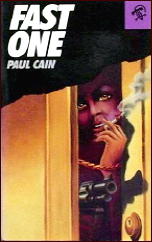
PAUL CAIN – Fast One. Doubleday Doran & Co., hardcover, 1933. First appeared in serialized form in non-consecutive issues of Black Mask magazine between March and September, 1932. Bond Mystery #10, digest paperback, 1945. Avon #178, pbbk, 1948; Avon #496, ppbk, 1952. Southern Illinois University Press, hardcover, 1978. Popular Library, paperback, “American Fiction” series, 1980. Black Lizard, paperback, 1987.
The hardest of the hard-boiled writers for Black Mask in the early 1930s was unquestionably Paul Cain (Peter Ruric). His style, as pulp authority Ron Goulart has noted, at times “becomes as sparse and clipped as that of a McGuffey’s Reader.”
In an afterword to the Southern Illinois reprint edition, critic Irvin Faust says that Cain “hasn’t the time or patience for excess baggage. He picks up his literary scalpel and scrapes away conjunctions as if they were bad merchandise… He digs into the page with a hard sentence: simple, declarative, exact.”
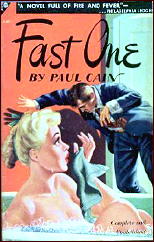
Fast One is Cain’s only novel. (He was primarily a screenwriter and is responsible for such films as One for the Money, Grand Central Murders, and Mademoiselle Foi.)
It was written on a bet and its various sections first appeared in Black Mask as five self-contained novelettes prior to book publication. It is unrelentingly grim and stark and brutal, to such an extent that it becomes uncomfortable to read; one begins to feel a kind of breathless despair well before the end.
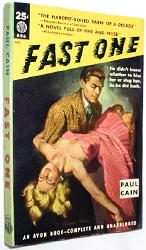
The “hero” is Gerry Kells, a mysterious loner, a criminal who insinuates himself into the Los Angeles underworld and wreaks havoc on its denizens and on others who happen to get in his way. The dust jacket blurb on a 1978 reissue by Southern Illinois University Press says about Kells:
“Only the strong prosper in the world of the Depression. Seemingly amoral, Kells does prosper. He strikes to survive, kills without conscience, without time for conscience. But he never becomes a mere killing machine. His integrity, his humanity, abides in a code demanding that he pay for all services: those rendered for him, those rendered against him. He pays with a two-sided coin-loyalty, revenge. He spends money freely, and those who cross him die hard.”
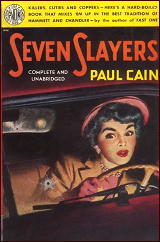
Cain knew his Los Angeles and he knew the ways of its Prohibition and post-Prohibition underworld. The portrait he paints of both, and of Gerry Kells, makes Fast One an important and compulsively readable novel, despite that feeling of breathless despair it engenders.
The only other book by Cain is Seven Slayers (1946), a collection of seven of his other Black Mask stories, all of which are in the same tough vein and all of which are excellent samples of pulp writing at its best.
———
Reprinted with permission from 1001 Midnights, edited by Bill Pronzini & Marcia Muller and published by The Battered Silicon Dispatch Box, 2007. Copyright © 1986, 2007 by the Pronzini-Muller Family Trust.
Thu 12 Apr 2012
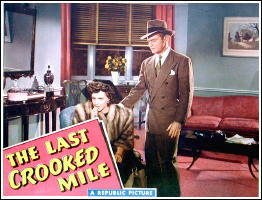
THE LAST CROOKED MILE. Republic Pictures, 1946. Donald Barry, Ann Savage, Adele Mara, Tom Powers, Sheldon Leonard, Nestor Paiva, Harry Shannon, Ben Welden, John Miljan, Charles D. Brown, John Dehner. Based on a radio play by Robert L. Richards. Director: Philip Ford.
Don “Red†Barry, as he usually was billed – he got the nickname from playing Red Ryder in the 1940 serial – was 5’ 4 ½†tall, making him an easy comparison with Jimmy Cagney, with same on-screen persona: brash and cocky, but as someone on IMDB has pointed out, without the same degree of menace. In the 1940s he had mostly western roles before switching to a more varied list of credits when TV came along.
In Last Crooked Mile, though, he plays a brash and cocky private eye named Tom Dwyer, who horns in uninvited on an armed robbery investigation to get a 10 percent reward for recovering the $300,000 that was stolen. The gang who pulled the job all died trying to make their getaway, and no one knows where the money went.
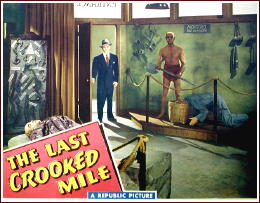
The car, though, that three of them cracked up in has been restored and is on display in a carnival. Although the car was searched many times with no success, Dwyer thinks it’s a good place to start, and do you know what? He’s right.
While chasing down and avoiding the various thugs and hoodlums who have the same idea, Dwyer meets two attractive women, which is one more than usual in short hour-length B-films like this. One is Adele Mara, who plays an old flame who resents being stood up too many times, and the other is Ann Savage (of Detour fame), who plays a nightclub singer and an old flame of the head of the gang who pulled off the robbery but who is now going straight.
Although the hiding place for the money is no big secret, there are a couple of twists to the tale, and one of them is actually a fairly good one. There is a decent amount of action, some humor (maybe a little too much) and some singing. That plus a storyline that makes sense, and you have a good 60 minutes of entertainment. Not noir, by any means, but still entertaining.
Thu 12 Apr 2012
A 1001 MIDNIGHTS Review
by Marcia Muller
DEREK MARLOWE – Somebody’s Sister. Viking, hardcover, 1974. Penguin, paperback, 1977. First published in the UK: Jonathan Cape, hardcover, 1974.
Somebody’s Sister is an attempt by a British author to write an American hard-boiled private-eye novel — and quite a successful attempt it is.
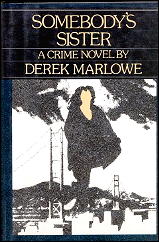
The investigator, Walter Brackett, is a fifty-three-year-old Englishman operating in San Francisco. His wife has died, his business has nearly gone to ruin, and he has an emotionally crippled partner, Harry Kemble, in a rest home.
Brackett visits Kemble every Saturday; otherwise he sits in his office above Fatty’s Delicatessen waiting for clients who seldom materialize. Brackett is likable and sympathetic but — in the tradition of the hard-boiled novel — he keeps his reader at a distance.
On this particular Saturday, Brackett returns from his usual visit to find the police waiting: A young girl has been killed in an auto accident on the Golden Gate Bridge, and Brackett’s card was in the car; the police want him to make an identification.
At the morgue, Brackett finds the girl is Mary Malewski, a prospective client who wanted him to find her father; Brackett never investigated for her, however, because she suddenly ran out of his office. Also at the morgue Brackett encounters a man named Loomis who apparently witnessed the accident.
Later Loomis leaves a message asking Brackett to visit him at his Sausalito motel. Brackett goes, but before he can talk to the man, Loomis is fatally shot in the car wash across the street! The police tell Brackett to stay out of the investigation; Loomis was a drug informer, involved in something too big for a down-at-the-heels private eye. But Brackett can’t stay out of it; he senses Loomis’s death and that of the girl are connected.
So he digs — in the lowly dives of North Beach where the girl lived; in an expensive home in Pacific Heights where her aging lover resides — until he finally must face a personally shattering truth.
The book is well plotted, and just when the reader thinks he knows what is really going on, he encounters another unexpected twist. In fact, its only faults are minor: a clue that could have been better placed; geographical discrepancies that are more likely to bother San Franciscans than anyone else; the San Francisco police having jurisdiction over a crime which happens in Sausalito across the Bay. (The novel is dedicated to newspaper columnist Herb Caen, who is often referred to as “Mr. San Francisco”; perhaps if Marlowe had consulted Caen, these discrepancies wouldn’t have happened.)
Unfortunately Marlowe — who has written a number of other suspense novels, including the well-received Dandy in Aspic (1966) — chose not to make Brackett a series character.
———
Reprinted with permission from 1001 Midnights, edited by Bill Pronzini & Marcia Muller and published by The Battered Silicon Dispatch Box, 2007. Copyright © 1986, 2007 by the Pronzini-Muller Family Trust.
Thu 12 Apr 2012
Posted by Steve under
Reviews[6] Comments
IT IS PURELY MY OPINION
Reviews by L. J. Roberts
DEBORAH CROMBIE – No Mark Upon Her. William Morrow, hardcover, February 2012.
Genre: Police procedural. Leading character: Det. Supt. Duncan Kincaid; 14th in series. Setting: England.
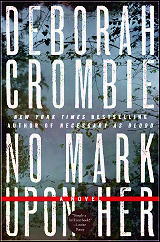
First Sentence: A glance at the sky made her swear aloud.
Police Detective Chief Inspector Rebecca Meredith, also an Olympic rowing contender, has gone missing. When a K9 team locates her body, it is clear her rowing accident was no accident. Pressure in brought to bear on Detective Superintendent Duncan Kincaid to solve the case quickly and quietly, but things are not as simple as they appear.
On a personal level, one thing I enjoyed about this particular book is the setting; it’s one of the few areas of England I’ve been fortunate enough to visit and come to know. I’ve always appreciated Ms. Crombie’s vivid descriptions, but this was especially fun for me.
Although I am always glad to move away from the angst-driven detective to those who have families and personal lives, there can be way too much of a good thing. The case and the mystery were very nearly drowned in details of Duncan Kincaid and his wife Gemma’s life. While that adds veracity to the characters and story, I found it overwhelming and distracting to the point where I was close to not finishing the book.
What saved it, for me, is that Ms. Crombie does write a very good police procedural. There is good tension and some very well-done plot twists. Sadly, I correctly identified the killer almost from the first appearance in the story.
Ms. Crombie is a wonderful writer. Unfortunately, No Mark Upon Her was, for me, far from her best book. I’d prefer to see her leave the kids and the dogs more in the background and focus on her fine ability to write a really good mystery.
Rating: Okay.
« Previous Page — Next Page »


